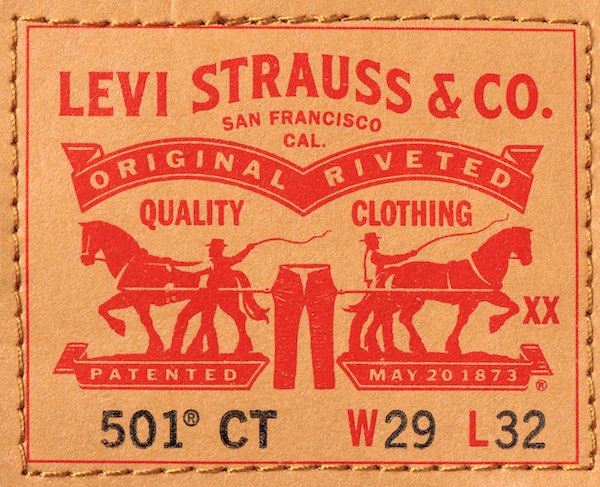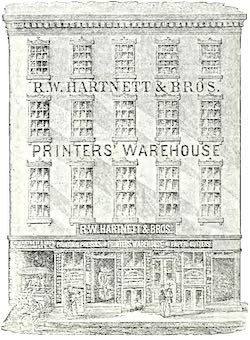
Most of us do not have to read this label to instantly know that this patch is attached to a pair of the eponymous Levi Strauss original 501 denim blue jeans. The label and the look say it all, these are genuine Levi’s.
Marlon Brando wore a pair of Levi’s 501s in the 1953 movie The Wild One, forever changing blue jeans from farmers’ garb to the ultimate symbol of counterculture cool. James Dean solidified the hip image in 1955 in the film Rebel Without a Cause when his jeans stood out in stark contrast to the letterman sweaters and poodle skirts then popular on high school campuses. Marilyn Monroe made the stitching of the backside pockets famous in a photo for Life Magazine. More recently, Steve Jobs, Bruce Springsteen, Kurt Cobain, and Barack Obama, among many others, all made Levi’s 501s their cool uniform of choice. Regardless of the wearer, we immediately know authentic Levi’s jeans because they sport the printed leather patch (or faux leather nowadays) with the two-horses logo sewn onto the waistband. Printing lets us know that we have the real deal.
OpSec Group, headquartered in Lancaster, Pennsylvania, acquired Global Trim. Based in Yorba Linda, California, Global Trim provides a wide range of custom labels, tags, stickers, and patches for branded apparel. The company’s labels adorn many of the brands we admire and purchase. Highly focused and dedicated solely to serve the needs of the apparel manufacturing industry, the company utilizes many production technologies, including woven labels, printed cloth labels, highly decorated printed hangtags, printed heat transfers, molded silicon, and yes, even leather patches that are printed and debossed.
The buyer, OpSec Group, provides a range of services to protect brand identity and related intellectual property rights, including the management of trademark and brand licenses, monitoring compliance with government and brand regulations such as ethical sourcing requirements, product identification and traceability, enforcement of brand ownership, protection of online digital content, and product authentication technologies. Consistent with its corporate mission to protect intellectual property, with its acquisition of Global Trim, the company now provides distinctive product labels, hangtags, packaging, and other forms of identification that uniquely identifies its customers’ brands. Printing and imaging are integral to the recognition that we associate with the value of a product.
Brand Identity Meets On-Demand Mass Customization
Avery Dennison has announced the acquisition of the Silver Crystal Group. The acquired company manufactures custom sports jerseys that will match any jersey style, from any year, with any name and number, and with the exact fonts associated with the selected team. In the ultimate example of on-demand mass customization, the company has over 250 onsite mini-factories at sports arenas and major league stores where fans can order totally unique one-off versions of a personalized jersey at a user-friendly kiosk. The unique garment is produced on-site while customers watch the game. The jerseys are ready to be picked up when the game is over. Orders can also be placed on mobile and online e-commerce ordering platforms. It’s the apparel version of an automated on-demand white-paper workflow. (See The Target Report: On Demand Everything—May 2021.)
Avery Dennison will be integrating the Silver Crystal Group into its Embelex division, hailed as a full-service end-to-end platform for on?product branding, graphics, and trims. Technologies employed include printing of heat transfer graphics, woven labels and patches, embroidery, raised silicone screen printing, molded silicone, and welded screen printed plastic that can be embossed or debossed.
The Silver Crystal acquisition follows Avery Dennison’s acquisition earlier this year of another company that specializes in textile labeling. In January, the company acquired Syracuse, New York-based Thermopatch, which specializes in labeling, embellishments, and heat transfers for sportswear, industrial laundry, workwear, and other fabrics that need to be labeled or branded.
On?Product Printing Promotes Safety
 R-V Industries acquired the business of R.W. Hartnett, located in Philadelphia, Pennsylvania. The acquired company manufactures on?product printing equipment for the pharmaceutical, nutraceutical, and confectionery industries. Founded in 1879, the company was established on Philadelphia’s “Printers Row,” just two blocks from the historic printing shop operated by Ben Franklin. In the 1800s, the company maintained an inventory of machine parts and specialized in the repair of printing, bookbinding, and related machines. Shortly after the company’s founding, the company introduced a three-roller ink mill under its own name, competing with the German and English ink mills of the day. With over 60 employees, the company had developed a reputation as excellent mechanics and engineers.
R-V Industries acquired the business of R.W. Hartnett, located in Philadelphia, Pennsylvania. The acquired company manufactures on?product printing equipment for the pharmaceutical, nutraceutical, and confectionery industries. Founded in 1879, the company was established on Philadelphia’s “Printers Row,” just two blocks from the historic printing shop operated by Ben Franklin. In the 1800s, the company maintained an inventory of machine parts and specialized in the repair of printing, bookbinding, and related machines. Shortly after the company’s founding, the company introduced a three-roller ink mill under its own name, competing with the German and English ink mills of the day. With over 60 employees, the company had developed a reputation as excellent mechanics and engineers.
In 1934, the Ford Gum Company, manufacturers of chewing gum and still in business today, asked the Hartnett engineers to design a machine that could print on gumballs. The success of the unique gumball printing machine led soon thereafter to the development of highly specialized printing presses that could print on tablets and capsules, a critical need for the burgeoning pharmaceutical business in and around Philadelphia. In 1949, the company applied for patents on the first tablet and capsule printing machines (it looks like an odd version of the Multilith offset press that I operated as a teenager). From the early 1950s on, the company continued to develop patented machines capable of printing on little spherical-shaped objects, including not only pharmaceutical products, but jellybeans as well.
The acquisition of R.W. Hartnett is R.V. Industries’ second move into the on?product printing segment this year. In June, the company acquired the Ackley Machine Corporation in Moorestown, New Jersey. The acquired company designs and manufactures machines that utilize rotogravure offset printing, with options to print in multiple colors and on both sides. Similar to its impact in other printing segments, inkjet technology has made inroads into the business of printing on objects that require non-contact marking. Lasers are employed in other machines for marking difficult-to-print object such as softgel tablets.
The slow, but steady, secular decline of paper-based commercial printing continues to erode the traditional segments of the printing industry that produce brochures, magazines, catalogs, and newspapers. At the same time, developments in on?product printing technology have increased the options for what can be printed and labeled, strengthening brand identities and improving product safety. (See The Target Report: How Do You Print a Golf Ball?—July 2016). Combined with on-demand customer interfaces that enable mass customization, new methods of on?product printing continue to open up new opportunities in print.
View The Target Report online, complete with deal logs and source links for October 2023


















Discussion
Join the discussion Sign In or Become a Member, doing so is simple and free